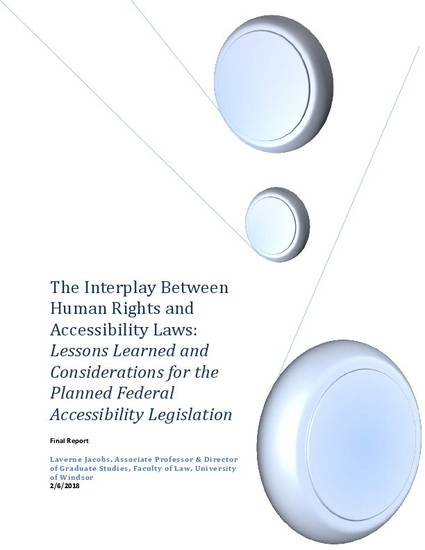
Other
The Interplay Between Human Rights and Accessibility Laws: Lessons Learned and Considerations for the Planned Federal Accessibility Legislation
(2018)
Abstract
In this study, the author analyzes, comparatively, the administrative governance functions of legislation that provides accessibility standards in six jurisdictions that also offer legal protection from discrimination to people with disabilities: Australia, the United Kingdom, the United States and the Canadian provinces of Ontario, Manitoba and Nova Scotia. The following governance functions were examined: a) creating accessibility standards, b) enforcing accessibility standards, c) enforcing decisions,d) encouraging compliance, e) raising public awareness (and promoting systemic culture change) and f) public education. The study was conducted with a view to understanding how human rights laws, principles and values can be used to further and strengthen disability access laws on the ground.
The federal government has proposed to introduce legislation that will likely establish a framework for the development of accessibility standards within Canada’s federal legislative jurisdiction. This follows on the heels of accessibility legislation being enacted in Ontario (2005), Manitoba (2013) and, most recently, Nova Scotia (2017).
Public consultations in 2016-17 for the proposed federal accessibility legislation identified confusion about the practical differences between human rights laws and accessibility laws, and the need for more clarity about how these two laws interact. This study was commissioned to examine the interplay between human rights legislation and accessibility legislation in Canada and internationally.
Based on the research findings, several recommendations are made regarding the complete set of governance functions examined. These recommendations include: incorporating a mechanism for public enforcement within the enforcement of accessibility standards, incorporating human rights supports and technical expertise within the development of standards, strengthening the statutory language to ensure an inclusive equality approach, avoiding confusion between reactive and proactive approaches to accessibility legislation by keeping the two systems distinct, and, establishing a Commissioner to take leadership in promoting awareness and systemic culture change, in encouraging compliance and in public education both across the federal government and with the general public.
Finally, throughout this report, the author argues that all administrative governance functions in the proposed federal accessibility legislation should be guided by and promote an inclusive equality approach. Inclusive equality is a theoretical framework put forward by the UN that focuses on recognizing the intersectionality of individuals with disabilities in their experiences of disability discrimination. Power relations, access to justice, and the socio-historical context surrounding legal efforts to realize equality by people with disabilities within a reactive regulatory (complaints-based and adjudicative) system should also be considered through this lens.
The views expressed in this document are those of the author and not those of Employment and Social Development Canada (Government of Canada) (ESDC).
Keywords
- accessibility legislation,
- human rights law,
- disability,
- governance,
- administrative law,
- comparative law
Disciplines
- Administrative Law,
- Civil Rights and Discrimination,
- Comparative and Foreign Law,
- Disability Law,
- Human Rights Law,
- Law and Society,
- Legislation,
- Public Law and Legal Theory,
- Social Welfare Law,
- Legal Studies,
- Other Legal Studies,
- Other Public Affairs, Public Policy and Public Administration and
- Public Administration
Publication Date
Winter February 6, 2018
Citation Information
Laverne A. Jacobs. "The Interplay Between Human Rights and Accessibility Laws: Lessons Learned and Considerations for the Planned Federal Accessibility Legislation" (2018) Available at: http://works.bepress.com/laverne-jacobs/6/